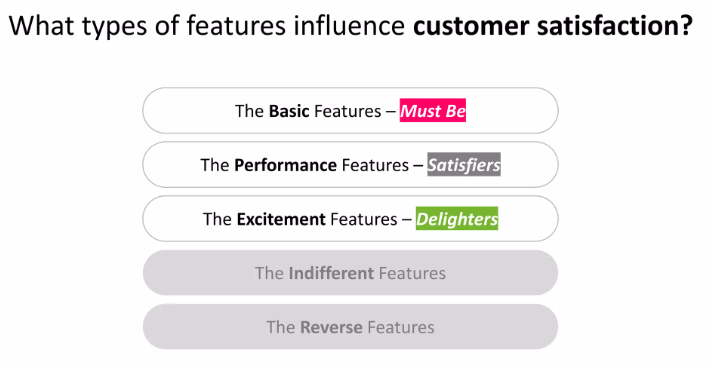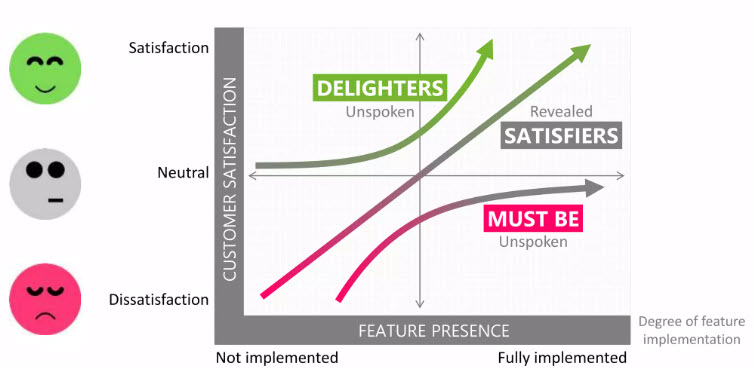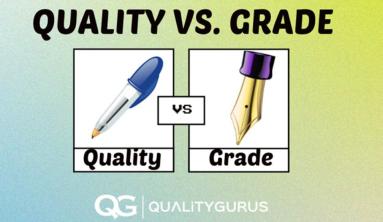Customers do know what they want but may not be proficient at describing their needs. The KANO model identifies three types of customer needs. By understanding the three types of customer needs and how to reveal them with the KANO model, the project team can use this information to guide the improvement process.
The development of the KANO model Six Sigma
Noriaki Kano, a Japanese researcher and consultant, published a paper in 1984 with a set of ideas and techniques that help us determine our customers’ satisfaction with product features. These ideas are commonly called the KANO Model. The KANO model Six Sigma shows that there is a basic level of quality that consumers assume the product will have. When listening to Voice of Customer, the team might classify the data into three categories. The categories are Must-be, Primary Satisfiers, and Delighters. This classification is called a KANO Analysis.
- A must-be requirement can dissatisfy, but cannot increase satisfaction. It is a basic requirement of the customer; they will not do business without it.
- A Primary Satisfier requirement is one where the more of these requirements that are met, the more satisfied the customer
- A delighter does not cause dissatisfaction if not present, but it will delight clients if present
The team must ensure that the process meets the must-be’s, increases the primary satisfiers, and potentially adds delighters.

Example
Please have a look at an example of a KANO model. This is what the diagram looks like.

How does it work?
The KANO model shows that there is a basic level of quality that customers assume the product will have. For example, all cars have windows and tires. If asked, customers don’t even mention the basic quality items, they take them for granted. However, if this quality level isn’t met the customer will be dissatisfied.
Basic and Expected Quality
Note that the entire ‘Basic Quality’ curve lies in the lower half of the chart, representing dissatisfaction. Providing basic quality is not enough to create a satisfied customer. The ‘Expected Quality’ line represents those expectations which customers explicitly consider. The model shows that customers will be dissatisfied if their quality expectations are not met; satisfaction increases as more expectations are met.
Exciting quality
The ‘Exciting Quality’ curve lies entirely in the satisfaction region. This is the effect of innovation. Exciting quality represents unexpected quality items. The customer receives more than they expected. Competitive pressure will constantly raise customer expectations. Today’s exciting quality is tomorrow’s basic quality.
Reverse Quality
These attributes refer to a high degree of achievement resulting in dissatisfaction and to the fact that not all customers are alike. For example, some customers prefer high-tech products, while others prefer the basic model of a product and will be dissatisfied if a product has too many extra features.
Examples:
- A restaurant so crowded that it generates huge queues, may be good for the owner, but displeasing to customers.
- In a similar way, the smaller the internal space, the lower the satisfaction of vehicle owners.
- The fewer options and variety on the menu of an airline, the lower the satisfaction of its customers.
- In a callcenter, using a lot of jargon, using excessive pleasantries, or using excessive scripts while talking to customers might be off-putting for them.
- In a hotel, producing elaborate photographs of the facilities that set high expectations which are then not satisfied upon visiting can dissatisfy the customers.
Keeping up with changing customer expectations
Firms that seek to lead the market must innovate constantly. Conversely, firms that seek to offer standard quality must constantly research customer expectations to determine the currently accepted quality levels. It is not enough to track competitors since expectations are influenced by outside factors as well. For example, the quality revolution in manufacturing has raised expectations for service quality as well.
Quality changes with the times
Lastly, I would like to add that quality changes with the times.
Especially in the modern era, people's behavior and way of thinking are greatly affected by the continuous evolution of technology, and the world is changing at a rapid pace. In fact, there is a growing trend to demand more business value from software and systems than ever before. For example, even if a information system is developed that works well, if not many people use it, it won't be evaluated.
In other words, we are entering an era where people believe that if no one uses the system, its quality is low. Therefore, it is becoming more and more important for developers to proceed with development more speedily, keeping in mind the business impact and value creation.
In this day and age where everyone is using digital devices such as smartphones in their daily lives, the expectations for software quality are becoming higher and higher.
Instructions to prepare KANO model
Here are the instructions to prepare KANO model:
- Generate a list of customer requirements. Don’t guess what they are – talk to your customers
- Review the KANO model
- Identify the appropriate category for each requirement. Work through the list of requirements one by one.
- Mark each product or service attribute as to whether it is a: disatisfier/basic requirement, satisfier/more is better or a delighter. Add a fourth category – not relevant. These are attributes that the customer does not care about.
- Determine priorities
How to determine priorities in a KANO model?
- First look at anything labeled as dissatisfiers or basic requirement. These represent customers’ minimal expectations, assess whether your organization is currently filling these requirements or not
- Perform the same assessment on the satisfiers. Are you doing them at all? Can you do more?
- If you aren’t meeting the basic requirements and have a lot of work to do on the satisfiers, don’t worry about the delighters yet. If you have all the basic requirements covered, and most of your satisfiers are done well, evaluate the delighters
Final Words
Based on the five categories of the Kano model, a product can be assessed based on the basic features, delighters, satisfiers and dissatisfiers to help determine what might be the best mix of features to attract customers. While the model itself is straightforward, it requires careful consideration for customer needs and wants. In order to be effective and accurate in performing a Kano analysis that truly reflects aspirations of customers and the unique selling point that can help make a product stand out.
Via TIGO Solutions


